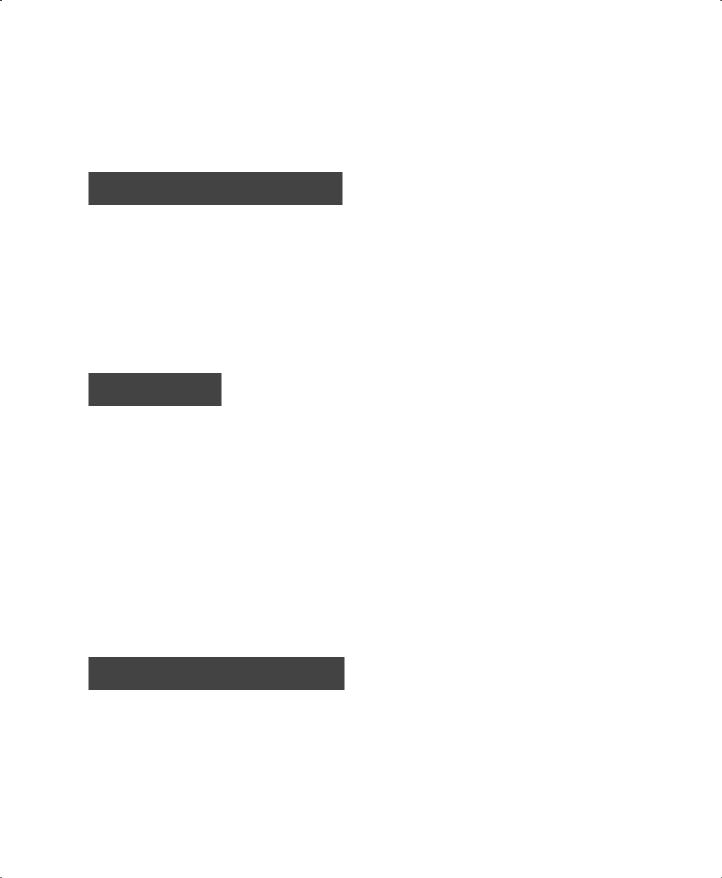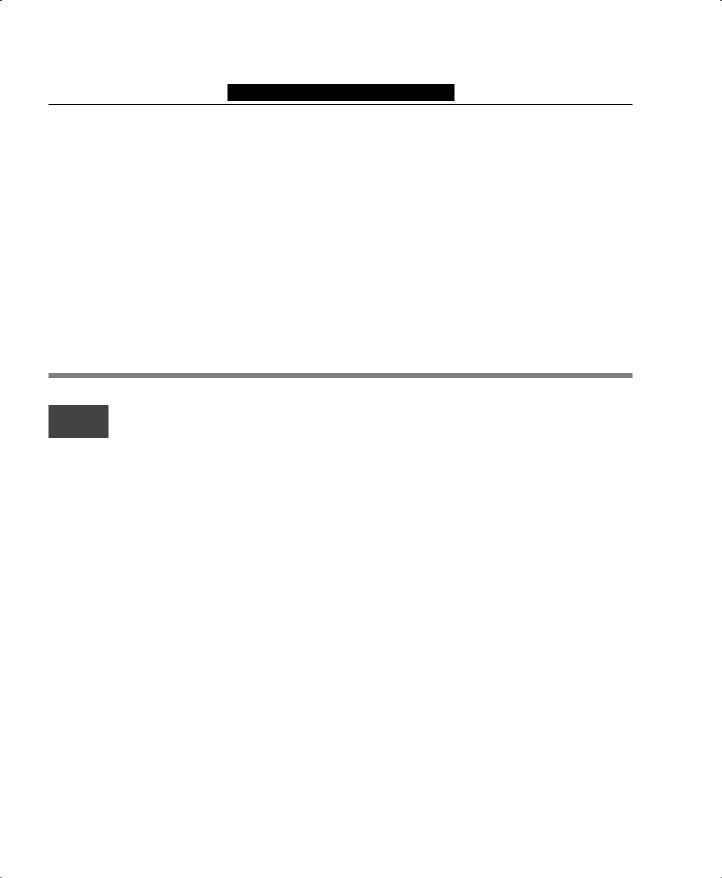
- •Contents
- •Preface
- •Acknowledgments
- •Founders of the Hotel Industry
- •E. M. Statler
- •Conrad Hilton
- •Cesar Ritz
- •William Waldorf Astor and John Jacob Astor IV
- •Kemmons Wilson
- •Ernest Henderson and Robert Moore
- •Ray Schultz
- •Historical Developments
- •Atrium Concept
- •Select-Service Hotels
- •Technological Advances
- •Marketing Emphasis
- •Total Quality Management
- •Major Reorganization, 1987–1988
- •Hotel Investment
- •September 11, 2001
- •Economic Downturn of the Late 2000s
- •Overview of the Hotel Industry
- •Types of Lodging Facilities
- •Hotels
- •Motels
- •All-suites
- •Select-service Hotels
- •Extended-stay Hotels
- •Market Orientation
- •Sales Indicators
- •Occupancy
- •Average Daily Rate (Average Room Rate)
- •Yield Percentage
- •RevPAR (Revenue per Available Room)
- •Levels of Service
- •Business Affiliations
- •Chain Affiliation
- •Referral Property
- •Company-owned Property
- •Management Contract Property
- •Brands
- •Independent Properties
- •Trends That Foster Growth
- •Leisure Time
- •The Me/Pleasure Concept
- •Discretionary Income
- •Family Size/Household Size
- •Business Travel
- •Female Business Travel
- •Travel as Experience
- •Career Development
- •Educational Preparation
- •Work Experience
- •Professional Memberships
- •Ports of Entry
- •Researching Growth Areas in the Hospitality Industry
- •Solution to Opening Dilemma
- •Chapter Recap
- •End-of-Chapter Questions
- •Notes
- •Key Words
- •Organization of Lodging Properties
- •Organization Charts
- •Typical Job Responsibilities of Department Managers
- •General Manager
- •Assistant General Manager
- •Food and Beverage Director
- •Physical Plant Engineer
- •Executive Housekeeper
- •Human Resources Manager
- •Marketing and Sales Director
- •Front Office Manager
- •Controller
- •Director of Security
- •Parking Garage Manager
- •Organization of the Front Office Department
- •Typical Front Office Organization
- •Select-service Hotel Front Office Organization
- •Function of the Front Office Manager
- •Job Analysis and Job Description
- •The Art of Supervising
- •Staffing the Front Office
- •Solution to Opening Dilemma
- •Chapter Recap
- •End-of-Chapter Questions
- •Key Words
- •Role of the Front Office in Interdepartmental Communications
- •Front Office Interaction with Other Departments in the Hotel
- •Marketing and Sales Department
- •Housekeeping Department
- •Food and Beverage Department
- •Banquet Department
- •Controller
- •Maintenance or Engineering Department
- •Security Department
- •Human Resources Management Department
- •Analyzing the Lines of Communications
- •Situation 1: Marketing and Sales Knows It All—But Didn’t Tell Us
- •Situation 2: Peace and Harmony in 507
- •Situation 3: I Know What You Said, and I Think I Know What You Mean
- •The Role of Total Quality Management in Effective Communication
- •An Example of Total Quality Management in a Hotel
- •Solution to Opening Dilemma
- •Chapter Recap
- •End-of-Chapter Questions
- •Key Words
- •Physical Structure and Positioning of the Front Desk
- •Guest First Impression
- •Creating a Balance Between Guest Flow and Employee Work
- •Selecting a Property Management System
- •Importance of a Needs Analysis
- •Procedure for Performing a Needs Analysis
- •Selecting a Team
- •Analyzing the Flow of Guests through the Hotel
- •Communicating Information
- •Reviewing Administrative Paperwork
- •Management Review of Information
- •Evaluate Needs That Have Been Identified
- •Assessing Needs Based on Findings
- •Choosing Software
- •Choosing Hardware
- •Other PMS Selection Considerations
- •Vendor Claims
- •Hardware Installation Plans
- •Computer Training Programs
- •Backup Power Sources
- •Maintenance Agreement
- •Financial Considerations
- •PMS Applications
- •Reservations
- •Revenue Management
- •Registration
- •Room Status
- •Posting
- •Call Accounting
- •Checkout
- •Night Audit
- •Inquiries/Reports
- •Back Office
- •Housekeeping
- •Food and Beverage
- •Maintenance
- •Security
- •Marketing and Sales
- •Personnel
- •Electronic Mail
- •Time Clock
- •Solution to Opening Dilemma
- •Chapter Recap
- •End-of-Chapter Questions
- •Notes
- •Key Words
- •Importance of a Reservation System
- •Overview of the Reservation System
- •Choice Hotels International
- •Hilton Hotels
- •Marriott International
- •Global Distribution Systems (GDS) in Securing Reservations
- •Role of the Internet in Securing Reservations
- •Background on Room Rates Offered via the Internet
- •Effect of Internet on Pricing Rooms
- •Consumers Response to Use of the Internet—Third-Party Websites
- •Social Media
- •Financial Effects of Third-Party Reservations
- •Types of Reservation Systems
- •Franchisee
- •Referral Member
- •Sources of Reservations
- •Corporate Clients
- •Social/Military/Educational/Religious/Fraternal (SMERF)
- •Meetings/Incentive/Conference/Event (MICE)
- •Group Travelers
- •Leisure Travelers
- •Current Guests
- •Forecasting Reservations
- •Overbooking (Occupancy Management)
- •Revenue Management
- •Processing Guest Reservations
- •Systemwide Reservation Systems
- •Outsourcing Reservations
- •Types of Reservations
- •Reservation Codes
- •Cancellation Codes
- •Blocking Procedure
- •Process of Completing Reservations through a PMS
- •Database Interfaces
- •True Integration
- •Solution to Opening Dilemma
- •Chapter Recap
- •End-of-Chapter Questions
- •Notes
- •Key Words
- •Occupancy Percentage
- •Average Daily Rate
- •RevPAR
- •History of Yield Management
- •Use of Yield Management
- •Revenue Manager
- •Components of Revenue Management
- •Definition of Yield
- •Optimal Occupancy and Optimal Rate
- •Strategies
- •Forecasting
- •Star Report
- •Block-out Periods
- •Systems and Procedures
- •Channel Management
- •Feedback
- •Management Challenges in Using Revenue Management
- •Considerations for Food and Beverage Sales
- •Applications of Revenue Management
- •Scenario 1
- •Scenario 2
- •Scenario 3
- •Solution to Opening Dilemma
- •Chapter Recap
- •End-of-Chapter Questions
- •Notes
- •Key Words
- •Importance of the First Guest Contact
- •Components of the Registration Process
- •Capturing Guest Data
- •Guest Registration Procedure
- •Guest Hospitality
- •Inquiry about Reservation
- •Completion of Registration Card
- •Review Completeness of Registration Card
- •Extension of Guest Credit
- •Room Selection
- •Room Assignment from Inventory
- •Assigning Room Rates
- •Discuss Sales Opportunities
- •Assigning Room Keys
- •Security of the Key System
- •Maintaining the Key System
- •Registration with a PMS
- •Retrieving Reservation Form
- •Checking Room Inventory Option
- •Checking Room Status Option
- •Verifying Room Rate
- •Issuing Room Key
- •Obtaining Reports from the PMS
- •Self-Check-In
- •Solution to Opening Dilemma
- •Chapter Recap
- •End-of-Chapter Questions
- •Notes
- •Key Words
- •Common Bookkeeping Practices
- •Debits and Credits
- •Forms Used to Process Guest Charges and Payments
- •Folio, Transfers, and Paid-out Slips
- •Account Ledgers
- •Guest Ledger and City Ledger
- •Posting Guest Charges and Payments
- •Point-of-sale
- •Room and Tax
- •Transfers and Adjustments
- •Paid-Out
- •Miscellaneous Charges
- •Phone
- •Display Folio
- •Reports
- •Transferring Guest and City Ledgers to Accounts Receivable
- •Solution to Opening Dilemma
- •Chapter Recap
- •End-of-Chapter Questions
- •Key Words
- •Organizing Late Charges to Ensure Accuracy
- •Guest Checkout Procedure
- •Inquiring about Quality of Products and Services
- •Retrieving the Room Key
- •Retrieving and Reviewing the Folio
- •In-room Guest Checkout
- •Determining Method of Payment and Collection
- •Credit Cards
- •Bill-to-account (Direct Billing)
- •Cash and Personal Checks
- •Traveler’s Checks
- •Debit Cards
- •Assisting the Guest with Method of Payment
- •Money Wire
- •Travelers Aid Society
- •Auto Clubs
- •International Currency Exchange
- •Obtaining Future Reservations
- •Filing Documents
- •Relaying Guest Departures to Other Departments
- •Removing Guest Information from the System
- •Transfer of Guest Accounts to the Back Office
- •Checkout Reports Available with a Property Management System
- •Guest Histories
- •ZIP Code or Postal Code
- •Developing Conventions and Conferences
- •FAM Tours
- •Origination of Reservation
- •Frequency of Guest Visit
- •Types of Room Requested
- •Room Rates versus Occupancy Patterns
- •Tracking Social Media
- •Last Impressions of the Hotel
- •Solution to Opening Dilemma
- •Chapter Recap
- •End-of-Chapter Questions
- •Notes
- •Key Words
- •Importance of the Night Audit
- •The Night Auditor
- •The Night Audit Process
- •Posting Room and Tax Charges
- •Assembling Guest Charges and Payments
- •Reconciling Departmental Financial Activities
- •Reconciling Accounts Receivable
- •Running the Trial Balance
- •Goal of Preparing the Night Audit Report
- •Preparing the Night Audit Report
- •Departmental Totals
- •Bank Deposit
- •Accounts Receivable
- •Cashier’s Report
- •Manager’s Report
- •Formulas for Balancing the Night Audit Report
- •Room and Tax
- •Total Restaurant Sales and Sales Tax
- •Tips for Restaurant, Room Service, Banquet, and Lounge Employees
- •Room Service
- •Banquet Sales
- •Banquet Bar and Total Lounge Sales
- •Room Rental
- •Valet
- •Telephone Charges
- •Gift Shop Sales and Tax
- •Vending
- •Parking
- •Total Revenue and Total Write-Offs
- •Cash Sales and Accounts Receivable Balance
- •Credit Cards and Cash Applied to Accounts Receivable
- •Analysis of Accounts Receivable
- •Bank Deposit and Amount Transferred to Accounts Receivable
- •Cashier’s Report
- •Operating Statistics
- •Daily Flash Report
- •Reading the Flash Report
- •Reading the Night Audit
- •Solution to Opening Dilemma
- •Chapter Recap
- •End-of-Chapter Questions
- •Key Words
- •Importance of Hospitality
- •Managing the Delivery of Hospitality
- •Management’s Role
- •The Service Strategy Statement
- •Financial Commitment
- •Total Quality Management Applications
- •Developing a Service Management Program
- •Guest Cycle
- •Moments of Truth in Hotel Service Management
- •Employee Buy-in Concept
- •Screening Employees Who Deliver Hospitality
- •Empowerment
- •Training for Hospitality Management
- •Evaluating the Service Management Program
- •Follow-through
- •Interfacing with Other Departments in Delivering Hospitality
- •Customer Relationship Management
- •Solution to Opening Dilemma
- •Chapter Recap
- •End-of-Chapter Questions
- •Notes
- •Key Words
- •Determining Employee Hospitality Qualities
- •Job Analysis and Job Descriptions
- •Positive Hospitality Character Traits
- •Practicing Promotional Skills
- •Screening for Hospitality Qualities
- •An Outgoing Personality
- •Patience
- •Ability to Accept Constructive Criticism
- •Interest in Selling
- •Developing an Orientation Program
- •Economic Position of the Property in the Community
- •Overview of the Lodging Establishment
- •Employee Handbook
- •Policy and Procedure Manual
- •Introduction to the Front Office Staff
- •Equipment Overview
- •Interdepartmental Cooperation
- •Administering the Orientation Program
- •Selection of Orientation Leader
- •Developing a Training Program
- •Identification of Tasks and Job Management Skills
- •Preparing Step-by-Step Procedures
- •Management Concepts
- •Steps in the Training Process
- •Preparation: Get Ready
- •Delivery: Show Me
- •Administering a Training Program
- •Cross-training
- •Developing a Trainer
- •Job Knowledge
- •Training for Empowerment
- •Americans with Disabilities Act
- •Solution to Opening Dilemma
- •Chapter Recap
- •End-of-Chapter Questions
- •Notes
- •Key Words
- •The Role of the Front Office in Marketing and Sales
- •Planning a Point-of-sale Front Office
- •Set Objectives
- •Brainstorm Areas for Promotion
- •Evaluate Alternatives
- •Devise Incentive Programs
- •Theories of Motivation
- •Douglas McGregor
- •Abraham Maslow
- •Elton Mayo
- •Frederick Herzberg
- •Applying Motivation Theories
- •Maslow
- •Mayo
- •Herzberg
- •Training Programs for a Point-of-sale Front Office
- •Train in Sales Skills
- •Develop an Attitude of Presenting Opportunities
- •Let Employees Experience Hotel Services
- •Use Role-Playing to Create Your Own Training Video
- •Budgeting for a Point-of-sale Front Office
- •Feedback
- •Guest Test
- •Financial Results
- •Planning a Point-of-sale Front Office—An Example
- •Solution to Opening Dilemma
- •Chapter Recap
- •End-of-Chapter Questions
- •Notes
- •Key Words
- •Importance of a Security Department
- •Organization of a Security Department
- •Job Analysis of the Director of Security
- •In-House Security Departments versus Contracted Security
- •Room Key Security
- •Hard-key System
- •Electronic Locks System
- •Smart Card
- •Contactless Electronic Locks
- •Fire Safety
- •General Fire Code Requirements
- •Guest Expectations
- •Fire Safety Plan
- •Employee Training in Fire Safety
- •Guest Instruction in Fire Safety
- •Fire Action Communication Procedure
- •Emergency Communication
- •Developing the Emergency Communication Plan
- •Employee Safety Programs
- •Employee Safety Committee
- •Composition and Activities of the Safety Committee
- •Department Supervisors’ Responsibility
- •Safety Training Programs
- •Solution to Opening Dilemma
- •Chapter Recap
- •End-of-Chapter Questions
- •Notes
- •Key Words
- •Importance of the Housekeeping Department
- •Overview of a Housekeeping Department
- •Relationship of the Executive Housekeeper to the General Manager
- •Management of a Housekeeping Department
- •Room Assignment/Workload
- •Outsourcing Housekeeping Activities
- •Housekeeper’s Report
- •Communication
- •Situation 1: Why Can’t Room Attendants Get Those Rooms Cleaned More Quickly, or, If That Guest Asks One More Time…
- •Inventory Control
- •Fixtures
- •Theft Control of Inventory
- •In-house Laundry versus Outsourced Laundry
- •Occupational Safety and Health Administration
- •Material Safety Data Sheets
- •Americans with Disability Compliance
- •Professional Associations
- •Role of Chief Engineer in a Lodging Property
- •Job Analysis
- •Job Description
- •Technology
- •Managing Maintenance Inter-departmental Communications
- •Energy Management
- •The Greening of the Lodging Industry
- •Leadership in Energy and Environmental Design (LEED)
- •Solution to Opening Dilemma
- •Chapter Recap
- •End-of-Chapter Questions
- •Notes
- •Key Words
- •Glossary
- •Index

E N D - O F - C H A P T E R Q U E S T I O N S 189
period, a jazz concert is scheduled in the city. In the past, reservations from this group plus walk-ins have allowed you to achieve 100 percent occupancy (200 rooms) at a $135 rate (rack rate is $95). However, the jazz enthusiasts do not have a positive history of large food and beverage purchases. What would you do, and on what would you base your decision?
Solution to Opening Dilemma
The front office manager must check the room availability for this period in the reservation module. She must determine if any block-out periods already exist and, if so, what minimum room-night restrictions are in force. She must also check with the food and beverage manager to determine the availability of banquet facilities and food services and the financial implications that may influence the decision. The revenue manager must provide information on rates and minimum reservation periods appropriate for the dates requested. If the decision leans toward rejection of the offer, the sales manager should consider public relations implications.
Chapter Recap
This chapter discussed the traditional concepts of occupancy percentage and average daily rate in determining the effectiveness of management’s efforts to achieve a positive income statement. RevPAR was used to answer the question “How many dollars is each room producing?” Yield management was introduced as a tool hoteliers can use in developing guest room sales strategies and evaluating potential food and beverage purchases to ensure a higher profit. The concept of yield management was borrowed from the airline industry, which shares a common operational design with the hotel industry. Components of yield management include revenue realized, revenue potential, optimal occupancy and optimal rates, strategies, block-out periods, forecasting, systems and procedures, feedback, and challenges front office managers face in implementing and using yield management. These concepts have been adopted into a daily revenue management operations practice and require the services of a revenue manager to monitor all opportunities to sell room inventory at various room rates and evaluate the potential financial impact of groups.
End-of-Chapter Questions
1.Explain in your own words the concept of revenue management.
2.What does a revenue manager do as a member of the hotel management team?
3.How are yield management and revenue management related?
4.What does occupancy percentage tell the owner of a hotel? Discuss the shortcomings of this concept in measuring the effectiveness of a general manager.

190 C H A P T E R 6 ■ R E V E N U E M A N A G E M E N T
5.Similarly, discuss the use of occupancy percentage versus the average daily rate (ADR) in determining the effectiveness of a general manager. What impression does quoting the ADR only give the owner of a hotel?
6.How can RevPAR assist hotel managers in measuring the effectiveness of front desk staff and marketing managers?
7.What similarities in operational design do the airline industry and the hotel industry share?
8.What are the goals of revenue management? If you are employed at a front desk in a hotel, do you see these goals being achieved?
9.Determine the yield for a hotel that has 200 rooms available for sale with a rack rate of $80, all of which are sold at $75.
10.Determine the yield for a hotel that has 275 rooms available for sale with a rack rate of $60, of which150 are sold at $75.
11.Determine the yield for a hotel that has 1000 rooms available for sale with a rack rate of $135, of which 850 are sold at $100.
12.Determine the yield for a hotel that has 100 rooms available for sale with a rack rate of $95, of which 85 are sold at $75.
13.Determine the yield for a hotel that has 190 rooms available for sale with a rack rate of $125, of which 100 are sold at $93.
14.Determine the yield for a hotel that has 525 rooms available for sale with a rack rate of $140, of which 367 are sold at $119.
15.Discuss the concepts of yield and occupancy percentage as illustrated in questions 10 through 14.
16.Discuss strategies to use when demand is high.
17.Discuss strategies to use when demand is low.
18.Why should a revenue manager set daily rate strategies as opposed to general period rate strategies?
19.In your own words, explain the term block-out period.
20.Why is sharing revenue management strategies with the front office staff so important to the success of the revenue management program?
21.What role does the transient guest play in the success of achieving yield?
22.What information can be obtained by reviewing the breakdown of rooms sold by rate category in the daily report? What should a hotel staff do with this information?

E N D - O F - C H A P T E R Q U E S T I O N S 191
23.How can review of the various sales channels assist the revenue manager in his or her job?
24.Why should turnaway business be reviewed daily? What should the hotel staff do with this information?
25.What role do potential food and beverage sales play in revenue management? What are your thoughts on rejecting the role of this concept in achieving yield?
C A S E S T U D Y 6 0 1
Ana Chavarria, front office manager at The Times Hotel, has completed a revenue management seminar at Keystone University and is preparing an argument in favor of adopting this concept at The Times Hotel to present to Margaret Chu, the general manager. Ana begins by compiling a history of room occupancy and ADRs, which she hopes will reveal areas in which revenue management could help. She prepares an electronic spreadsheet that lists rooms sold with corresponding room rates and correlates the data to tourism activities in the area. Ana sends an analysis of revenue realized and revenue potential to Ms. Chu for review prior to their discussion.
After reviewing the analysis, Ms. Chu concludes, “This is just another scam; the industry is slow to adopt this,” and disregards the entire report. She knows that occupancy percentage, ADR, and RevPAR are all you need to be efficient today, so why change?
Ana passes Ms. Chu in the lobby. Ms. Chu indicates her distrust of the revenue management concept but says she will listen to Ana’s presentation tomorrow.
What tips could you give Ana to help her present a sound case for the adoption of revenue management?
C A S E S T U D Y 6 0 2
Suggest revenue management strategies to use under the following circumstances at The Times Hotel:
Situation 1: The Train Collectors will be in town from November 10 through November 15 and will draw 50,000 people. Every room in town is expected to be taken for that period. What policy should the hotel develop for guests who want to reserve a room for the following periods?
■November 10 only
■November 10 and 11 only
■November 10, 11, and 12 only
■November 11, 12, and 13 only
■November 12, 13, and 14 only
■November 13, 14, and 15 only
■November 13 and 14 only
■November 14 and 15 only
■November 15 only
Situation 2: The last two weeks of December are usually slow for room sales, but a local Snow and Ice Festival will attract visitors who may request reservations for single overnight accommodations. What policy should the hotel develop for accepting such room reservations?

192 C H A P T E R 6 ■ R E V E N U E M A N A G E M E N T
C A S E S T U D Y 6 0 3
Suggest revenue management strategies to use under the following circumstances at The Times Hotel:
Situation 1: The Bee Keepers will be in town from January 19 through January 25 and will draw 8,000 people. No other conferences are scheduled for the nights of January 19–21 in the area; two other conferences are opening in town on the night of the 22nd that will last through the night of the 25th. These last two conferences will take up all the existing rooms in town. What policy should the hotel develop for guests who want to reserve a room for the following periods?
■January 19 only
■January 19 and 20 only
■January 19, 20, and 21 only
■January 19 through 24 only
■January 19 through 25 only
■January 20 through 24 only
■January 21 through 24 only
■January 22 through 24 only
■January 23 and 24 only
■January 24 and 25 only
Situation 2: The Times Hotel wants to rethink its policy on food and beverage sales with regard to its impact on revenue management. What concepts would you suggest they review as they develop their policy?
Notes
1.Robert McMullin, “Why Do Hotel/Resort Room Rates Fluctuate Throughout the Year?” Pocono Record, August 29, 2002.
2.S. E. Kimes,“Basics of Yield Management,” Cornell Hotel and Restaurant Administration Quarterly 30, no. 3 (November 1989): 15.
3.Ibid., 15–17.
4.“The ABCs of Yield Management,” Hotels 27, no. 4 (April 1993): 55. Copyright Hotels magazine, a division of Reed USA.
5.Manizer, 2009.“Revenue Management Doesn’t Take a Back Seat During a Downturn,” http://www.hotel-online.com/News/PR2009_1st/Jan09_RMSystem.html
6.Julie Squires, 2009. “Build Profitability in 2009: Maestro PMS Proactive Yield Management Enables Operators to Thrive in Challenging and Competitive Marketplace,”http://www.hotel-online.com/News/PR2009_2nd/Apr09_ MaestroPMS.html.
7.Benchmark Hospitality International at Leesburg, VA (Benchmark Hospitality managed by The Woodlands—Houston, TX). Management job listing, benchmark, hospitalityonline.comjobs/6300/.
8.HSMAI, 2007. “Study Delves into the Revenue Management Profession,” http:// www.hotel-online.com/News/PR2007_2nd/Jun07_RevMgrIssues.html.
9.E. Orkin, “Boosting Your Bottom Line with Yield Management,” Cornell Hotel and Restaurant Administration Quarterly 28, no. 4 (February 1988): 52.
10.Ibid., 53.
